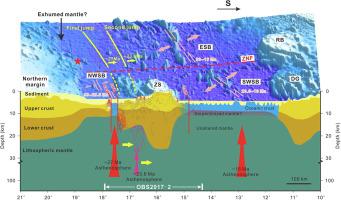Gondwana Research ( IF 7.2 ) Pub Date : 2021-06-24 , DOI: 10.1016/j.gr.2021.06.015 Yuhan Li , Haibo Huang , Ingo Grevemeyer , Xuelin Qiu , Haoyu Zhang , Qiang Wang

|
Continental rifting, break-up, and onset of seafloor spreading are inherently controlled by the segmentation and structure of the continental domain suffering from extension. Today, the Zhongsha Atoll (ZS) is wedged between the Northwest Sub-basin (NWSB) and the Southwest Sub-basin (SWSB), two oceanic abyssal basins of the South China Sea (SCS). The nature of the crust and the structure of the transition from continental to oceanic domain are key to revealing the processes and dynamics during the rifting and break-up of the Zhongsha block. In this paper, we present a P-wave velocity model obtained from both forward modeling and tomographic inversion of wide-angle seismic line OBS2017-2. The results support the continental nature of the Zhongsha Block with a thickness of up to ~25 km. However, the transition from the thick continental domain of the ZS into both adjacent abyssal basins shows clear differences. To the north, a ~120 km wide domain of extended continental crust was observed. Farther north, the NWSB is characterized as a narrow basin with typical oceanic crust. The transitional domain between the continental and oceanic crust shows a ~30–40 km wide region with a high-velocity lower crust reflecting excessive magmatism. In contrast, the SWSB is characterized by a sharp transition from the thick continental crust of the ZS to thin oceanic crust which is probably underlain by serpentinized mantle. The strong rheological properties of the pre-rift crust in the western part of the SCS margin may be the reason that rifting concentrated on narrow rifts and thinning focused on necking domains, while the ZS avoided any intense extension. The configuration of rigid blocks thereafter affected the break-up position and the style of oceanic crust.
中文翻译:

南海中沙地块及邻近深海盆地下地壳结构:对裂谷和海底扩张起始的新认识
大陆裂谷、破碎和海底扩张的开始,本质上是受受伸展的大陆域的分割和结构控制的。今天,中沙环礁 (ZS) 夹在西北次海盆 (NWSB) 和西南次海盆 (SWSB) 之间,这是南海 (SCS) 的两个大洋深海盆地。地壳性质和陆域向洋域过渡的结构是揭示中沙地块裂谷破碎过程和动力的关键。在本文中,我们提出了从广角地震线 OBS2017-2 的正演建模和层析反演中获得的 P 波速度模型。结果支持中沙地块的大陆性,厚度可达~25 km。然而,从 ZS 的厚大陆域到两个相邻的深海盆地的过渡显示出明显的差异。在北部,观测到了约 120 公里宽的扩展大陆地壳区域。再往北,NWSB 的特点是一个狭窄的盆地,具有典型的洋壳。大陆地壳和大洋地壳之间的过渡域显示出约 30-40 公里宽的区域,下地壳的高速反映了过度的岩浆作用。 . . . . . . . . . . . . . . . . . . . . . . . . . . . . . . . . . . . . . . . . . . . . . . . . . . . . . . . . . . . . . . . . . . . . . . . . . . . . . . . . . . . . . . . . . . . . . . . . . . . . . . . . . . . . . . . . . . . . . . . . . . . . . . . . . 相比之下,SWSB 的特点是从 ZS 厚的大陆地壳急剧过渡到薄的洋壳,这可能是蛇纹状地幔的下伏。南海边缘西部裂谷前地壳的强流变性质可能是裂谷集中在窄裂谷、减薄集中在颈缩域的原因。而 ZS 避免了任何强烈的延伸。此后刚性块体的构造影响了大洋地壳的破裂位置和样式。











































 京公网安备 11010802027423号
京公网安备 11010802027423号